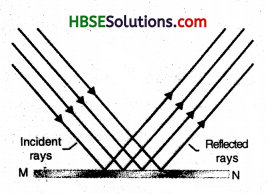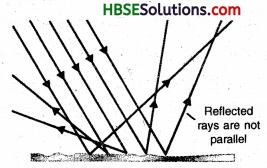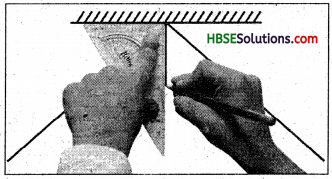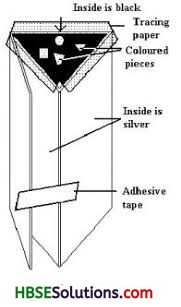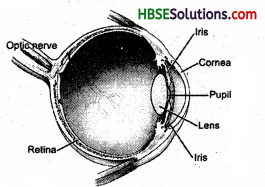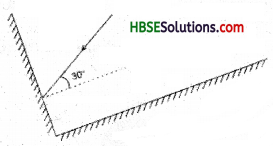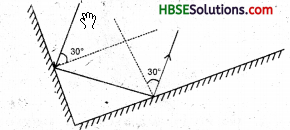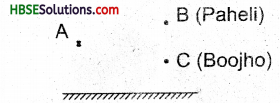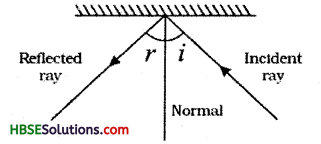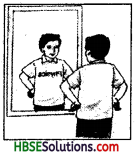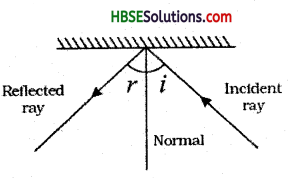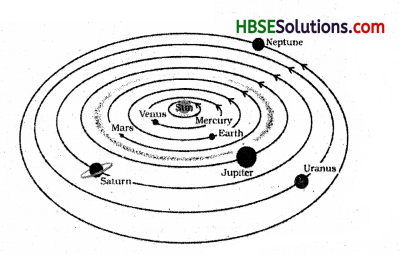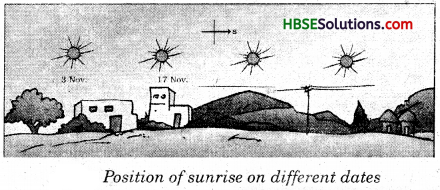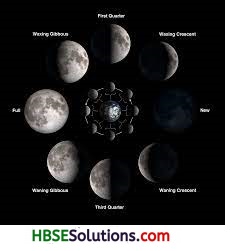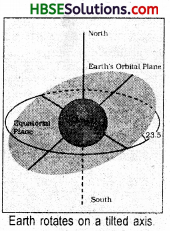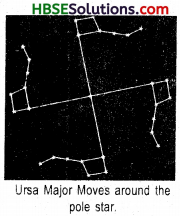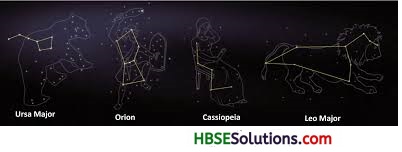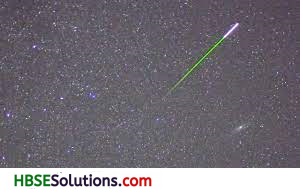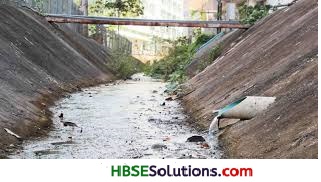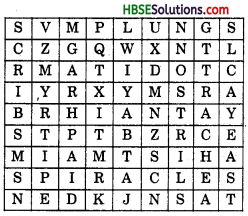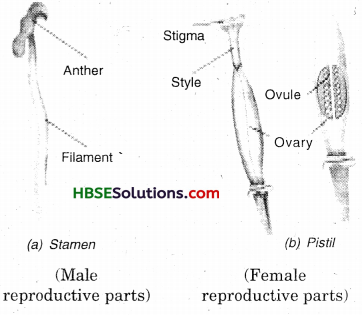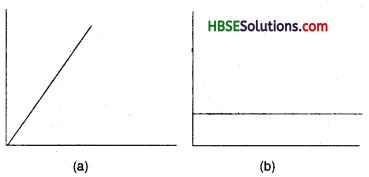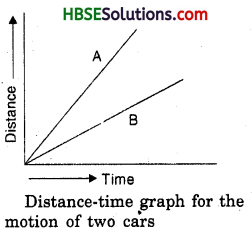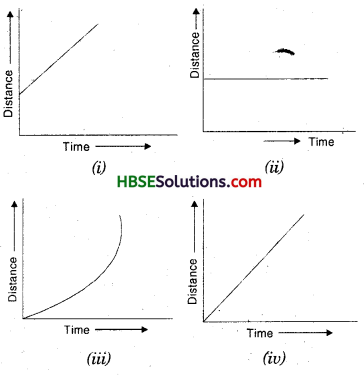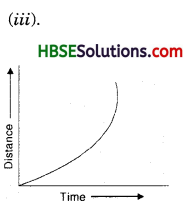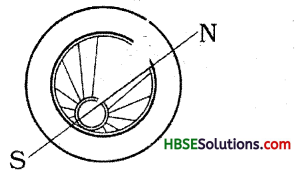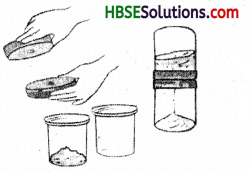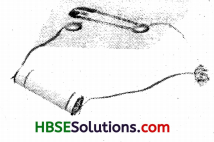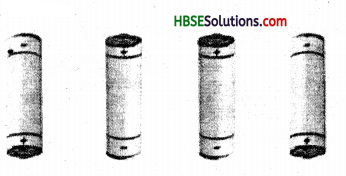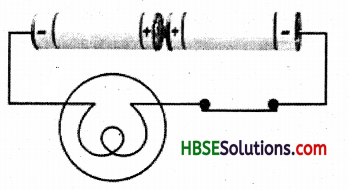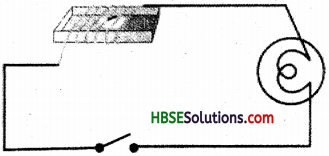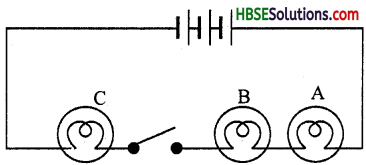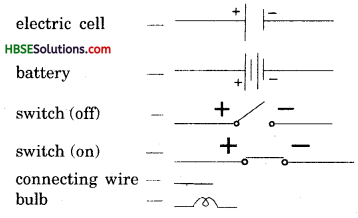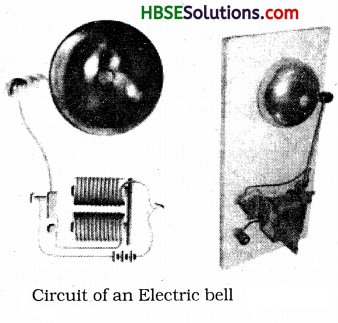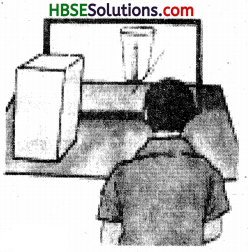HBSE 8th Class Science Solutions Chapter 15 Some Natural Phenomena
Haryana State Board HBSE 8th Class Science Solutions Chapter 15 Some Natural Phenomena Textbook Exercise Questions and Answers.
Haryana Board 8th Class Science Solutions Chapter 15 Some Natural Phenomena
HBSE 8th Class Science Some Natural Phenomena Textbook Questions and Answers
Question 1.
Which of the following cannot be charged easily by friction?
(a) A plastic scale
(b) A copper rod
(c) An inflated balloon
(d) A woollen cloth.
Answer:
(b) A copper rod
Question 2.
When a glass rod is rubbed with a piece of silk cloth the rod
(a) and the cloth both acquire positive charge.
(b) becomes positively charged while the cloth has a negative charge.
(c) and the cloth both acquire negative charge.
(d) becomes negatively charged while the cloth has a positive charge.
Answer:
(b) becomes positively charged while the cloth has a negative charge.
Question 3.
Write T against true and F against false in the following statements:
(а) Like charges attract each other. (T/F)
(b) A charged glass rod attract a charged plastic straw. (T/F)
(c) Lightning conductor cannot protect a building from lightning. (T/F)
(d) Earthquakes can be predicted in advance. (T/F)
Answer:
(a) False
(b) True
(c) False
(d) False
![]()
Question 4.
Sometime, a crackling sound is heard while taking off sweater during winters. Explain.
Answer:
This occurs due to electric discharge between sweater and body. Some energy is always released with electric discharge, which in this case is released in form of a cracking sound.
Question 5.
Explain why a charged body loses its charge if we touch it with our hand.
Answer:
When we touch a charged body, it loses its charge, due to process of earthing. Our body is good conductor of electricity and transfers the charges to the earth.
Question 6.
Name the scale on which the destructive energy of an earthquake is measured. An earthquake measures 3 on this scale. Would it be recorded by a seismograph? Is it likely to cause much damage?
Answer:
Destructive energy of an earthquake is measured in Ricther Scale. Yes, it will be recorded in this scale. Earthquake with megnitude of 3 on Richter Scale is not much destructive.
Question 7.
Suggest three measures to protect ourselves from lightning.
Answer:
Three measure to stay protected from lightning are:
- Stay indore or under covered area.
- Don’t take bath during lightning.
- We should not use T.V. or phone during lighning.
Question 8.
Explain why a charged balloon is repelled by another charged balloon whereas an uncharged balloon is attracted by another charged balloon?
Answer:
A charged balloon is atracted by another charged balloon because both carry same charge like charge always repel each other. While the uncharged balloon is attracted by charged balloon due to unlike charged.
Question 9.
Describe with the help of a diagram an instrument which can be used to detect a charged body.
Answer:
An electroscope can be used to detect if a body is charged or not. When the metal strips repel each other proves that the body is charged as repulsion is the sure test to detect if a body carries charge or not.
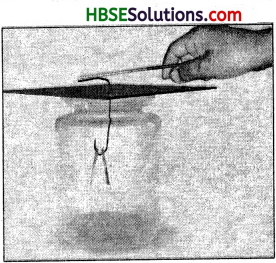
Question 10.
List three states in India where earthquakes are more likely to strike.
Answer:
Kashmir, Punjab and Gujarat are more prone to earthquake.
![]()
Question 11.
Suppose you are outside your home and an earthquake strikes. What precaution would you take to protect yourself?
Answer:
We will take following precautions :
- We will try to move to an open space.
- If we are driving, we will slow down the vehicle and move slowly away from that area.
- We will not take shelter under trees or buildings.
Question 12.
The weather department has predicted that a thunderstorm is likely to occur on a certain day. Suppose you have to go out on that day. Would you carry an umbrella? Explain.
Answer:
No, we will not take an umbrella, as this will increase the risk of lighting because wide objects are more prone to lightning strike.
Extended Learning – Activities and Projects
Question 1.
Open a water tap. Adjust the flow so that it forms a thin stream. Charge a refill. Bring it near the water stream. Observe what happens. Write a short report on the activity.
Answer:
For self attempt.
Question 2.
Make your own charge detector. Take a paper strip roughly 10 cm x 3 cm. Give it a shape as shown in Fig. 15.15. Balance it On a needle. Bring a charged body near it. Observe what happens. Write a brief report, explaining its working.
Answer:
For self attempt.
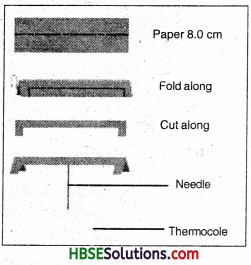
Question 3.
This activity should be performed at night. Go to a room where there is a fluorescent tube light. Charge a balloon. Switch off the tube light so that the room is completely dark. Bring the charged balloon near the tubelight. You should see a faint glow. Move the balloon along the length of the tube and observe how glow changes.
Caution: Do not touch the metal parts of the tube or the wires connecting the tube with the mains.
Answer:
For self Attempt.
Question 4.
Find out if there is an organisation in your area which provides relief to those suffering from natural disaster. Enquire about the type of help they render to the victims of earthquakes. Prepare a brief report on the problems of the earthquake victims.
For more information on these topics, visit:
→ science.howstuffworks.com/lightning.htm
→ science.howstuffworks.com/ earthquake .htm
→ www enchantedlearning.com/subjects/ astronomy/planets/ earth/continents.shtml
Answer:
For self attempt.
HBSE 7th Class Science Some Natural Phenomena Important Questions and Answers
Very Short Answer Type Questions
Question 1.
Name any three natural phenomena.
Answer:
Earthquakes, cyclones, lightning.
Question 2.
According to ancient Greeks who invented thunderbolts?
Answer:
Goddess of Wisdom Minerva.
Question 3.
What are the sparks seen in sky during thunderstorms?
Answer:
Lightning.
![]()
Question 4.
Which resin did Greeks knew, produced sparks on rubbing continuously?
Answer:
Amber.
Question 5.
What happens when we rub a plastic scale with our hair?
Answer:
It gets charged.
Question 6.
What happens when charged plastic scale is brought close to bits of paper?
Answer:
Papers get attracted towared scale.
Question 7.
What happens when we rub an inflated balloon and let it free near a wall?
Answer:
Balloon gets attached to the wall.
Question 8.
How many types of charges are gained by rubbing objects?
Answer:
Two.
Question 9.
Name the charges bodies acquire on rubbing.
Answer:
Positive charge and negative charge.
Question 10.
What happens when similar charged bodies are brought close?
Answer:
They repel each other.
Question 11.
What happens when two different charged bodies are brought close?
Answer:
They attract each other.
Question 12.
What will happen when a charged glass rod is brought close to a charged straw?
Answer:
They will attract each other.
Question 13.
What will happen when a charged pen refil is brought close to a charged balloon?
Answer:
They attract each other.
Question 14.
Which charge is conventionally called a positive charge?
Answer:
Charge on a charged glass rod.
Question 15.
A charged glass rod attracts a charged straw. What is the charge on the charged straw?
Answer:
Negative charge.
![]()
Question 16.
What is the electric charge generated by rubbing called?
Answer:
Static electricity.
Question 17.
What is the static electricity?
Answer:
Charges which are produced by rubbing and are not movable are called static electricity.
Question 18.
How is electric charges different from static charges?
Answer:
Electric charges can flow but static charges cannot move.
Question 19.
What is used to transfer electrical charges from one body to another?
Answer:
Metallic conductors.
Question 20.
What is the transfer of charges from one body to earth is called?
Answer:
Earthing.
Question 21.
What provision is made in buildings to prevent electrocution?
Answer:
Earthing of wires is done.
Question 22.
How a huge energy is produced during thunderstorm?
Answer:
By repulsion of negative charges from clouds and positive charges from ground.
Question 23.
What is the process of meeting of negative charges from clouds with positive charges from ground to release huge energy called?
Answer:
Electric discharge.
Question 24.
Which place is safe during thunderstorms and lightning?
Answer:
Covered vehicles and buildings.
Question 25.
What should be considered as alert signs to get a safe place during thunderstroms?
Answer:
Hearing thunder without lightning.
Question 26.
Is sitting on a motor-cycle safe during lightning?
Answer:
No.
Question 27.
Where should one take shelter in open during lightning?
Answer:
Under small trees.
Question 28.
Is it safe to use wired phones during lightning?
Answer:
No.
![]()
Question 29.
Can a lightning victim electrocute another person?
Answer:
No.
Question 30.
What harms can lightning cause in a lightning victim?
Answer:
Loss of memory, loss of hearing or sight, broken bones etc.
Question 31.
What is the device used to save multistoryed buildings from lightning.
Answer:
Lightning rod.
Question 32.
Where is the lightning rod attached to protect the building from lightning?
Answer:
On the top of the building.
Question 33.
One end of the lightning rod is left loose in the air, where is the other end fixed or attached?
Answer:
Other end of the rod is attached to the ground.
Question 34.
Which fish can give electrical shock?
Answer:
Electrical eel.
Question 35.
What is the capacity of producing electric current in an electrical eel?
Answer:
650 volts.
Short Answer Type Questions
Question 1.
How can charging take place by rubbing?
Answer:
When a plastic comb is rubbed with hair it starts attracting small pieces of paper. Similarly, when two straws are rubbed with polythene and are brought close they repel each Other. Rubbing charges the comb and straws by loading charges on comb and straws, The polythene and hair against which straws and combs are charged also get charged.
Question 2.
How many types of charges do things acquire on rubbing?
Answer:
Charges acquired by objects are of two types named positive charge and negative charge. Charge acquired by a glass rubbed with silk is called positive charge and the charge acquired by the silk is called the negative charge.
Question 3.
How are negative and positive charges related to each other?
Answer:
Positive charges repel each other and negative charges repel each other. In other words similar charges repel each other. On the other hand negative charge is attracted by positive charges or in simple words opposite charges attract each other.
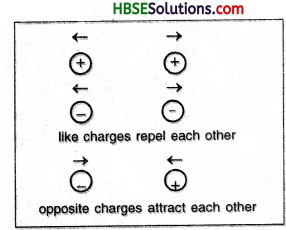
Question 4.
What is static electricity? How is it different from electric current?
Answer:
The electrical charges acquired by bodies on rubbing are called static electricity. These charges are called static because, they cannot move. This is the difference static electricity and electrical current has. Electrical current can move or flow but static electricity cannot move or flow.
Question 5.
What is electrical discharge?
Answer:
Transfer of charges from a body is called electrical discharge. If we touch a charged object, the charge gets transferred to the earth through our body. We say that the object is discharged. This is also called earthing. Electrical discharge can take place between any two conducting bodies.
Question 6.
How electrical discharge takes place in clouds?
Answer:
During thunderstorms the negative charges get accumulated near the clouds and positive charges accumulate near ground. When these negative and positive charges meet, electrical discharge takes place between clouds and grounds. It produces huge amount of energy which is released as lightning and thunder.
Question 7.
How do clouds get charged during thunderstorms?
Answer:
During thunderstorm there is a vigorous movement of air current in upward and downward direction i.e. in opposite direction. This is similar to rubbing of objects, this vigorous movements of water droplets in clouds cause charging of the clouds.
![]()
Question 8.
How does lightning strike during thunderstroms?
Answer:
During thunderstorms, the opposite charged clouds and ground come in contact and electrical discharged takes place between clouds and ground and huge energy is released as lightning. This is called lightning strike. Electrical discharge can take place between clouds and ground, clouds and human body, clouds and building etc.
Question 9.
How can we protect ourselves from lightning during thunderstorm when we are out of our home?
Answer:
Following precautions should be used when we are out during thunderstorm:
- We should not stay in open vehicles or places.
- Should not carry unbrella.
- Should not take shelter under tall trees or under poles etc.
- If shelter has to be taken, then it should be taken under smaller trees.
Question 10.
What precautions should we take to secure ourselves from lightning stroke during thunderstorm when we are in our homes?
Answer:
Following precautions should be taken while in house :
- We should not use wired phone.
- Electrical appliances should be plugged off.
- Should not bathe in running water.
Question 11.
Why is it advised to take shelter under smaller trees while in open during thunderstorms?
Answer:
During thunderstorms, we should take shelter under smaller trees because electrical discharge can easily take place with tall trees, so they are easy targets of lightning. While smaller trees are not in reach of lightning often.
Question 12.
How does a lightning rod protect a building from lightning?
Answer:
Lightning rods are installed on the top of the buildings. One end of the rod is left in open and the other one is connected to the earth.When lightning strikes the building, the charges are directly transferred to earth by the rod, this is called earthing. Earthing thus saves the buildings from lightning strike.
Question 13.
Why the Electric Eel is so called?
Answer:
Eel found in South America emits electric discharge from its body. It can produce electric current of 650 volts. It emits discharge to attack its enemies, to give shock to the prey. It can also give shock to human beings too. As these Eels produce electric discharge, they are called electric Eels.
Question 14.
What is an earthquake? How is it measured?
Answer:
Sudden trembling and shaking of the earth is called an earthquake. Due to sudden movements in the uppermost layer of the earth, the earth starts trembling, this movement of earth is called an earthquake. The magnitude of the earthquake is measured through an instrument called seismograph and it is measured on Richter scale.
Long Answer Type Questions
Question 1.
What is static electricity? How many kinds of charges are there?
Answer:
The electrical charge produced due to rubbing of objects is called static electricity. This charge cannot move as the electric current moves. These types of charges are produced only when objects are rubbed. When we rub an inflated balloon with our hair and let it loose, it attaches to wall. This proves that balloon has been charged. Similarly when a glass rod is rubbed with silk, it gets charged.
Charges are of two types : Negative charges and positive charges. Conventionally charge acquired by a glass rod is called positive charges and the charges acquired by the silk with which glass rod is rubbed aquires a negative charge. Similarly charged bodies repel each other and oppositely charged bodies attract each ether.
Question 2.
What is earthing? How is it useful?
Answer:
Transfer of charges to earth through conducting bodies is called earthing. In buildings wiring is done to do earthing when we touch the electric current, it enters the earth through our bodies. The bodies of the living beings including humans are good conductors of electricity. So, they easily acquire charges and transfer them to the earth, if they are in contact of the earth. This is called earthing.
Earthing is very useful as it protects us from electrocution. It prevents electric shocks as it transfers current to the earth. Earthing also saves building from lightning.
![]()
Question 3.
How does lightning take place during a thunderstorm?
Answer:
Lightning during thunderstorm takes place due to a phenomenon known as electric discharge. Electric discharge means interaction between oppositely charged objects. During thunderstorms vigorous upward and downward movement of air particles take place. This causes charging of water droplets accumulate in clouds and positive charge accumulates near ground. When these positive charges and negative charges meet a huge amount of energy is released in form of thunder and lightning. This whole process is called electrical discharge.
Question 4.
How can we save ourselves from lightning?
Or
What precautionary measures should be taken to save ourselves from lightning?
Answer:
Lightning gives a warning before appearing. Huge thunder without light is a warning. We should look for a safe place. No place in open is safe.
- One should rush to take shelter in building or house.
- One should not come out of the covered vehicle if on the road.
- One should not keep sitting on open vehicles like scooters, bikes etc.
- One should not take shelter under large and tall trees as they are easy target for electrical discharge.
- One should take shelter under smaller trees while in open as they are not easy target of lightning.
- If in open and no tree or shelter nearabout, one should sit with head folded under arms and embedded between the legs. One should not lie down in open.
- We should plug out all the electrical appliances during lightning.
- We should not use wired telephones during lightning, while mobiles and cordless phones are safe.
- One should not take ones bath during lightning.
Question 5.
What is a lightning rod? How is it used?
Answer:
Lightning rod is a device which is used to save tall buildings from lightning. Tall buildings are easy target to lightning as there can be easy electrical discharge with clouds. Lightning rod is a rod having three spikes on its top and a long earthing- wire to be attached to the earth. The end with spikes is left in open and other end is attached to earth. Lightning rod is fitted on the top of the buildings. During thunderstorm, when electrical discharge takes place between clouds and the building, the lightning rod acquires the charges and transfers them to the earth through its embedded end and saves the buildings from the strike of the lightning.
Question 6.
What is an earthquake? How does it occur?
Answer:
Sudden shaking and trembling of the earth is called earthquake. It occurs due to disturbance deep inside the upper layer of the earth. Earthquake is a natural phenomenon, which can be very devastating depending upon its intensity and magnitude.
The uppermost layer of the earth is not made up of a single flat surface. It is made up of different fragments, called seismic plates. These plates are joined with each other at different points. These plates are always in a continuous motion. Sometimes due to collision of these plates or upward or downward motion of these plates earth starts shaking. This is called an earthquake. The areas falling between these plates are the areas which are the most vulnerable areas for earthquakes. These are called fault zones or in simple language danger zones.
Question 7.
What is a seismograph? How does it work?
Answer:
Seismograph is an instrument which is used to record the intensity of the earthquake. Seismograph has a long rod suspended, with a pen attached to it. A paper is placed under the pen. When an earthquake strikes, the rod starts vibrating. The pen also starts vibrating and paper starts moving under the pen recording the movement of the pen. Scientists further study the seismic waves recorded by pen and make estimates about the intensity of the earthquake. This graph also gives the idea about the energy involved in the earthquake. This idea helps in determining the destructive power of the earthquake.
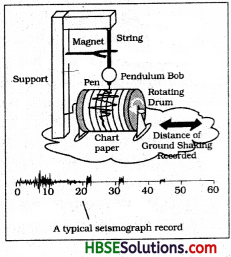
Some Natural Phenomena Class 8 HBSE Notes
- Natural phenomena like lightning, earthquakes etc. always made people fearful. People had many superstitions regarding these phenomena. They related these phenomenon to wrath and pleasures of Gods.
- Greeks knew that sparks like that of lightning also Occur when amber is rubbed with fur.
- Rubbing the objects with other objects can cause charging like rubbing a plastic scale with hair can charge the scale.
- Similar charged bodies repel each other while oppositely Charged bodies attract each other.
- Charges are of two types : negative and positive.
- Charges on a charged glass rod is said to be positive and other kind of charges are called negative charges.
- Opposite charges attract each other and similar charges repel each other.
- Charges which are generated due to rubbing are called static electricity. Static electricity means where charges do not move as in electric current.
- Charges can be transferred from one body to another. Charges can be transferred from a charged body to earth and this is called earthing.
- Lightning during rain is due to release of huge energy during electric discharge.
- Lightning can be dangerous, but we can secure ourselves by using precautions.
- Lightning rods can protect tall building from lightning as tall objects are easy target for lightning.
- Earthquake is another natural phenomena which can prove disastrous.
- Earthquakes take place due to disturbance in upper crusts of the earth.
HBSE 8th Class Science Solutions Chapter 15 Some Natural Phenomena Read More »
